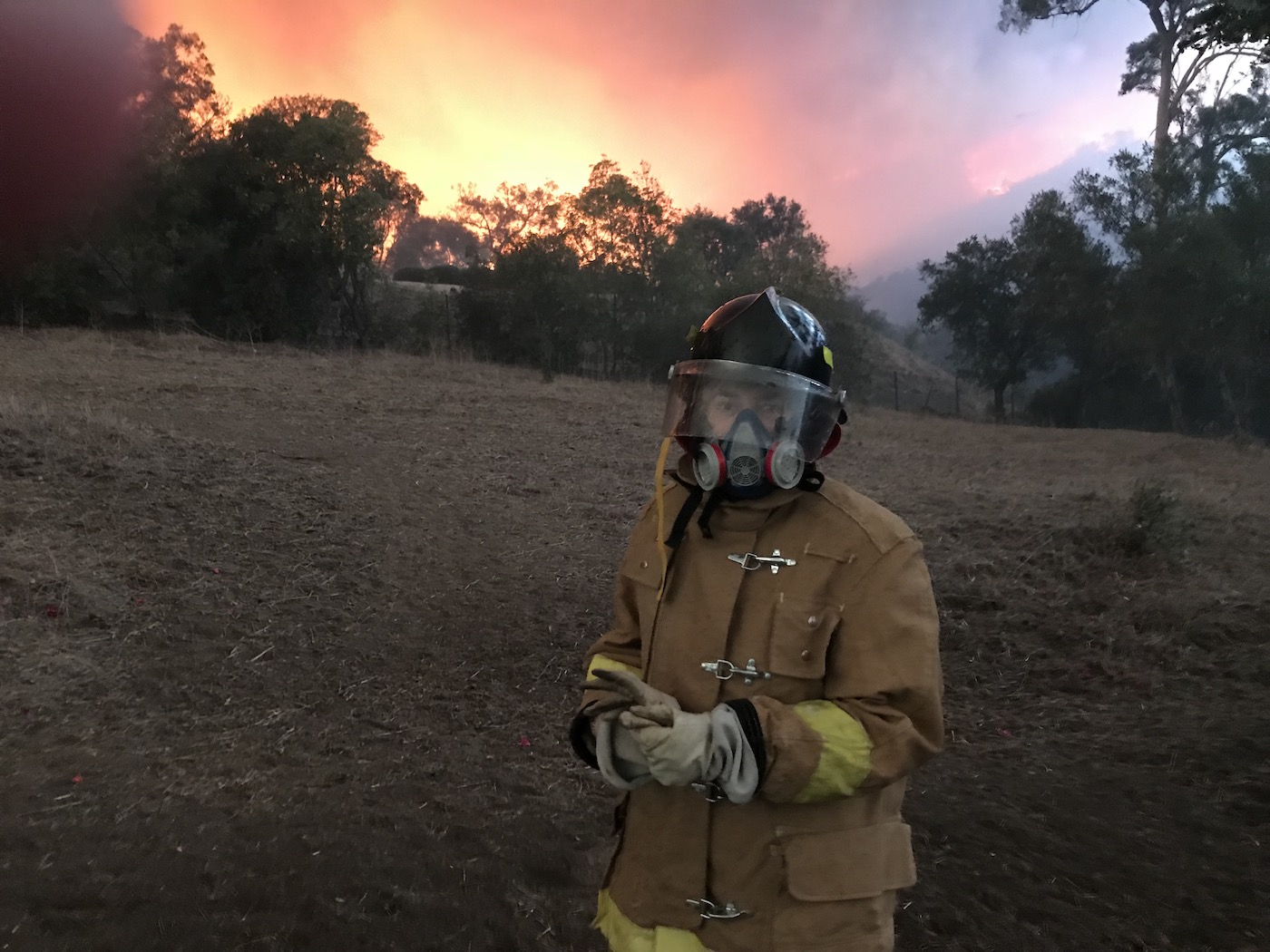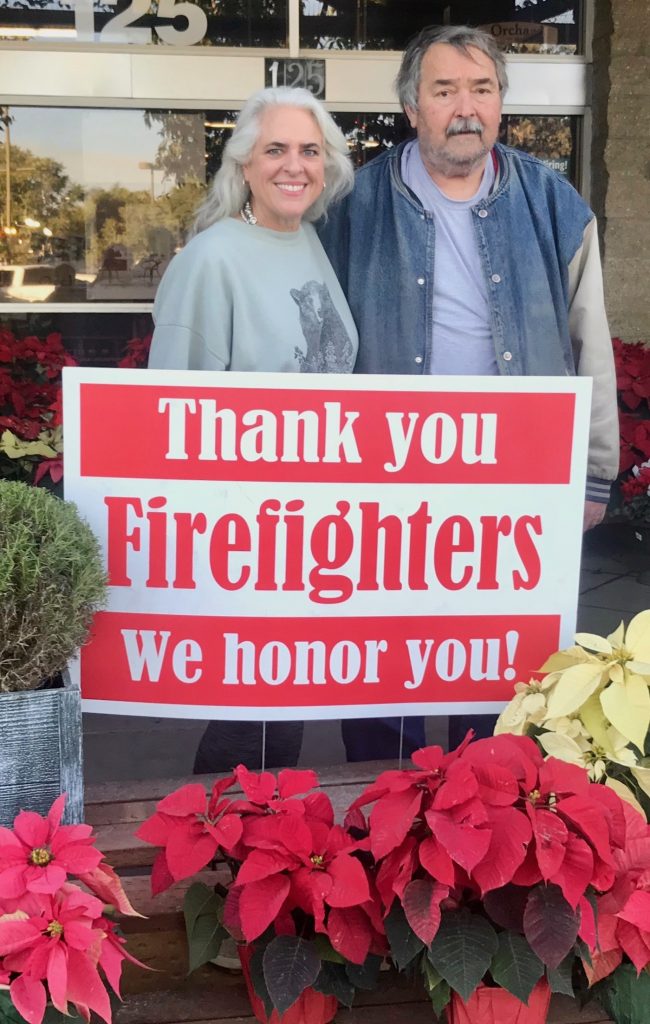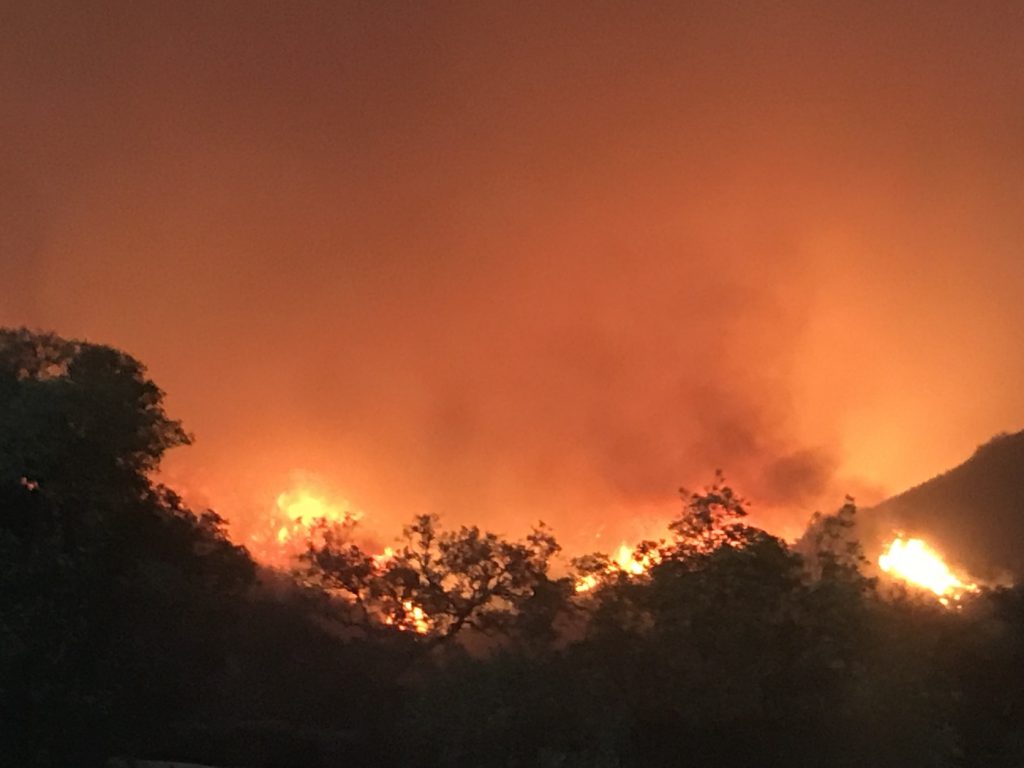A Tribute to Firefighter Bill from His Trusty Sidekick

“You’ve got a big-ass fire headed straight your way,” was the salty salutation I heard when answering the phone. The caller was William J. Myers, a lifelong family friend and veteran retired firefighter known more familiarly as Bill. I was a bit perplexed, as the only fire I had heard about at the time was something called the Thomas Fire, and it was way over in Santa Paula or Fillmore or someplace far from Santa Barbara. But I sit up and pay attention when Bill says something like that. You can’t help but do so, as Bill is known for his colorful language, which ninety percent of the time is delivered in a booming voice that can be heard all the way from his home in Tujunga.
Bill is familiar with Santa Barbara, as his late mother, Ethel, lived near Franceschi Park for many years. The Sycamore Canyon Fire, which destroyed more than 200 homes in July 1977, was the first Wildland-Urban Interface (WUI) fire Bill fought in Santa Barbara.
“I got real big pointers from that fire,” Bill once told me. “When I saw ice plant burn, I was impressed. Those sundowner winds are layered. The wind gets really strong down near the ground.”
Bill’s near-prophetic accuracy in predicting the path of wildfires is uncanny, but not voodoo. Armed with a degree in fire science, Bill has 40-plus years of experience in fighting wildland fires, which he finds more interesting than structural fires. But he is also a licensed building contractor, so he has a complete grasp of edifice fire behavior as well as the outdoors. Bill’s résumé is as long as my arm and includes positions with the U.S. Forest Service, plus chief of the Mount Wilson Fire Department in Los Angeles County for several years. He left the institutional bureaucracy of firefighting many moons ago and became an independent fire consultant and contractor, as well as a volunteer firefighter, and an arson watch volunteer for the Los Angeles County Sheriff’s Department.
I’ve known Bill all my life, as he became friends with my older brother when they were both in elementary school. Over a 25-year-period, he performed a number of building-related jobs for my late father, Philip Kirst. The most important of those projects was the engineering of a complex fire suppression system at our family home in Montecito, which he installed after the Tea Fire burned through large swaths of our area in 2008, destroying 210 homes.
Because Bill is completely devoted to my mother, Colleen Kirst, whom he considers his “second Mom,” he arrived – unasked but so welcome – on December 9. His truck, permanently outfitted with firefighting gear and a 160-gallon water tank, was packed to the gills with excess firefighting equipment (all of which we used). Bill arrived with a clear mission: to protect Mom’s house, as he didn’t want to see her burned out at 93 years of age. He knew I would stay and help as best I could, so we immediately began preparing for the arrival of the Thomas Fire, starting by getting our house and barn saturated with water from the many Rain Bird type sprinklers that are one aspect of our fire suppression system.

“We’re going to use the indirect method of fighting fire,” Bill told me many times over the course of the next week. A key component of that method was raising the humidity level on our property by keeping the now-saturated buildings wet with a twice daily “refresher” dose of water.
When mandatory evacuation orders for our section of East Mountain Drive were set in place the next day, we sent my mother to stay with relatives in the Los Angeles area. I had sent my horses to Santa Ynez a couple of days before, thanks to Bill’s accurate prediction that the polo fields in Carpinteria would be evacuated long before anyone I knew thought of that possibility. We explained to a sheriff deputy who visited, as well as every fire chief who approached us, that we knew we were defying the mandatory evacuation order, but we intended to exercise our right to stay and fight the fire. We prepared in earnest, with no idea that we would be sequestered together on the property for nearly two weeks. It was a strange, reverse “evacuation,” as we knew if we left that we would not be able to get back onto the property. We could see the street below us crawling with police and fire crews, and knew the roadblocks were in place.
Bill and I realized we were in a crucial spot, as our little 7-acre ranch sits immediately above the heart of Montecito as the crow flies. Even more ominously, it sits at the bottom of the Oak Creek Canyon drainage, where the sundowner winds can howl with a force not seen in other parts of Montecito. There has been many a time when I’ve arrived there to find hot, sustained winds of 30 to 40 mph blowing debris all over the place, when literally a few hundred yards down the road not a leaf is stirring.
Over the course of the week, Bill told me the fire could go straight to the beach, just like it had in Ventura County, if we didn’t stop it there. While that seemed a dramatic prediction, I knew better than to doubt Bill given his proven accuracy on calculating fire behavior. But in an abstract way, stopping the blaze seemed blithely doable to me, the optimist with no experience at firefighting. After all, we had this gonzo fire suppression system, right? A system that we dutifully demonstrated to every crew who wanted to know what kind of resources we had on hand.
In addition, I had removed nearly 100 eucalyptus trees over the last couple of years, to create what I was told many times by firemen was one of the most defensible spaces in Montecito. I also wanted our property to be used as a staging area by the fire crews, which indeed it was – all week. Dozens of vehicles were in and out of there all the time, and every night several engines and water tenders parked in the lower pasture. All this “firepower” only added to my feeling of confidence and security. Except for the growing number of moments when, with emerging alarm and an unsettling sense of dread, I would ask myself, “Just what the hell have I signed up for here?”
Those moments included Bill’s serious explanations about fire behavior and his scenarios for Plans A, B, C, D, E, and then Plan F, which stands for “Flee.” Watching the television news reports, as the fire marched steadily closer. The ominous dark skies, so filled with smoke that helicopters and air tankers were often prevented from making water drops. When Bill taught me how to operate a fire hose, of which he had laid out hundreds of feet, snaking all around the property. Augmented by the red canisters of numerous fire extinguishers, placed in strategic locations in case the water gave out. Which we hoped was unlikely, since we also have a 5,000-gallon water tank hooked to a backflow refill mechanism, with a gas-powered engine to run it and solar-powered battery back-up.
In addition to the large Rain Bird sprinklers such as those found on golf courses, we have a couple of “big guns,” the huge Rain Birds used in the logging camps of Oregon and Washington, calibrated to shoot 200 gallons of water per minute. We had 60 gallons of Class-A foam retardant to spray on the buildings, and we had flame-retardant fire shelters to crawl into for the worst-case scenario. But we also had the most important element of all: Bill Myers. A smart and fearless old grizzly bear who I characterize as a cross between Rooster Cogburn from True Grit and the infamous oil well firefighter Red Adair.
Perhaps the most sobering moment of all was when Bill taught me a last-resort survival technique: how to go into a 3-point drop to the ground and obtain oxygen from the end of the fire hose by sticking my face into a wide-angle fog pattern and placing my nose at just the right angle from the spraying water at the nozzle discharge. This wasn’t easy to practice when wearing the bulky, man-sized PPG he had brought me. That’s shorthand for “Personal Protective Gear,” i.e., a heavy firefighter suit. I silently blessed my Pilates teacher for strengthening my core muscles, as it’s nearly impossible to balance on both knees and one elbow while hanging onto the heavy hose with one hand. I got soaked in no time, but at least I didn’t drown myself.
No, wait. The most sobering moment was when all of Montecito immediately below us was placed under mandatory evacuation. All the way to the beach. The heart of Montecito, from the Village to the Four Seasons Biltmore. I thought of all the landmarks within that path, such as Casa del Herrero and Casa Dorinda. The churches of Our Lady of Mount Carmel, El Montecito Presbyterian and All Saints Episcopal. Montecito Union School, the Montecito Inn, and the Coral Casino beach club. The homes of many friends and neighbors, and the house where I lived with my late husband. The business district of Coast Village Road, all emptied. I swallowed hard when I received that particular text alert, because it was then that I knew in my heart Bill would never implement Plan F. But I silently determined I was damned if I was going to leave him there alone.

Lack of space prevents me from detailing what happened during our firefight on the morning of December 16. But that day, as well as the week before and the week after, was filled with numerous incidents that could have completely derailed our success. Some were funny and some were life-threatening. Several people have told me I should write a book about the whole experience, which I hope to do. Because this is really the story of one man’s strength and ingenuity, resilience and resourcefulness, proficiency and faith. It speaks to the American experience and our tradition of self-reliance.
But long story short: the fire arrived with a vengeance that nobody could have predicted. It blew up, which means the temperature soared above 2,000 degrees and the color turned white. The noise, the smoke, the winds, and the heat are indescribable. Bill and I didn’t know until later that the firefighters camped in my pasture just a few minutes before had been ordered to retreat to a safer area, along with all the other firefighting crews in our vicinity. So, we fought the fire for nearly two hours by ourselves, until it was safe enough for the crews to be allowed back in.
But Bill’s plan worked, and we were able to stop the center section of what was a three-part flanking fire from getting past us. It was stopped by the wall of humidity that he had created during the course of the preceding week, along with all his additional strategies. As for me, I just followed orders, knowing my life was in Bill’s hands, but trusting that he would bring us both through. And by the grace of God, he did.
Some of this story was made public by KEYT reporter Senerey de los Santos, who serendipitously did a television interview with Bill and me the night before the December 16 firefight, and again the day after. The follow-up story went national, and we jokingly called it “our 15 minutes of flame.” From the responses that both Bill and I have received from all over the country, we have slowly realized that ours was truly a unique and amazing experience. Bill’s dire prediction was confirmed when fire authorities were later quoted as saying they thought the wildfire was going to go all the way to the beach and were amazed when it didn’t.
I tip my hat – my firefighting helmet hat – to Bill Myers, an inimitable character whom I am proud to call my brother. He was successful in making sure that our mother had a house to come back to when the evacuation orders were lifted. Because of his dedication to that mission, so did many other people in Montecito. Among the nearly 9,000 first responders who battled the massive Thomas Fire, he’s the hero I especially think of whenever I see the signs posted all over town: “Thank You, Firefighters.”







You must be logged in to post a comment.